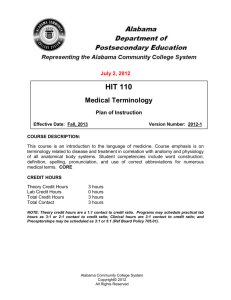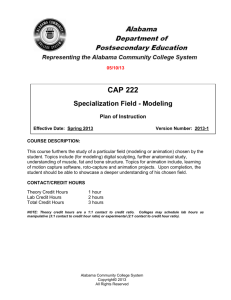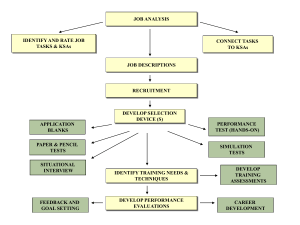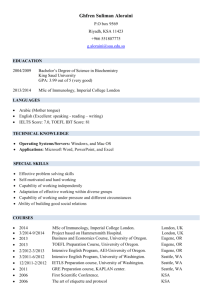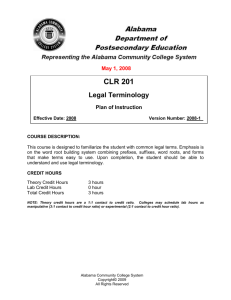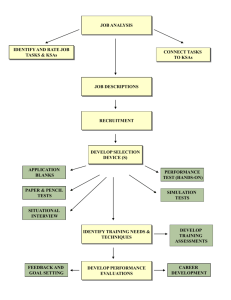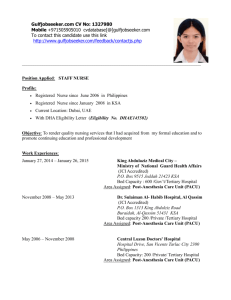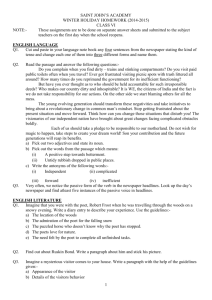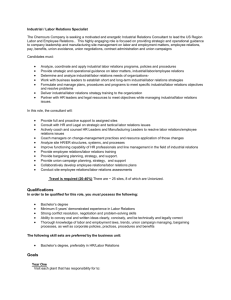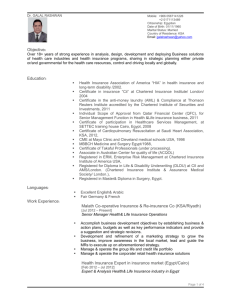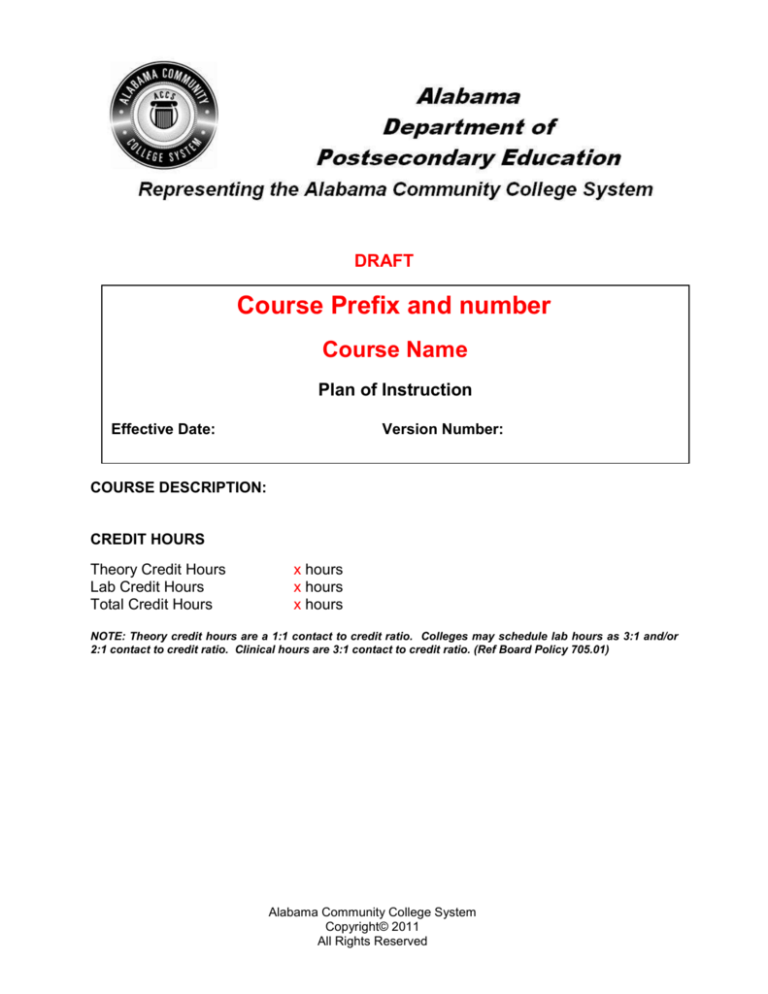
DRAFT
Course Prefix and number
Course Name
Plan of Instruction
Effective Date:
Version Number:
COURSE DESCRIPTION:
CREDIT HOURS
Theory Credit Hours
Lab Credit Hours
Total Credit Hours
x hours
x hours
x hours
NOTE: Theory credit hours are a 1:1 contact to credit ratio. Colleges may schedule lab hours as 3:1 and/or
2:1 contact to credit ratio. Clinical hours are 3:1 contact to credit ratio. (Ref Board Policy 705.01)
Alabama Community College System
Copyright© 2011
All Rights Reserved
Course name
course prefix & number
PREREQUISITE COURSES
As determined by college.
CO-REQUISITE COURSES
As determined by college.
PROFESSIONAL COMPETENCIES
INSTRUCTIONAL GOALS
Cognitive – Comprehend principles and concepts related to topic.
Psychomotor – Apply principles of topic.
Affective – Value the importance of adhering to policy and procedures related to
topic.
STUDENT OBJECTIVES
Condition Statement: Unless otherwise indicated, evaluation of student’s attainment
of objectives is based on knowledge gained from this course. Specifications may be in
the form of, but not limited to, cognitive skills diagnostic instruments, manufacturer’s
specifications, technical orders, regulations, national and state codes, certification
agencies, locally developed lab/clinical assignments, or any combination of
specifications.
ACCS Copyright© 2011
All Rights Reserved
2
Course name
course prefix & number
STUDENT LEARNING OUTCOMES
MODULE A –
MODULE DESCRIPTION –
PROFESSIONAL COMPETENCIES
A1.0
PERFORMANCE OBJECTIVES
A1.1
LEARNING OBJECTIVES
KSA
KSA
A1.1.1
MODULE A OUTLINE:
MODULE B –
MODULE DESCRIPTION –
PROFESSIONAL COMPETENCIES
B1.0
PERFORMANCE OBJECTIVES
B1.1
LEARNING OBJECTIVES
KSA
KSA
B1.1.1
MODULE B OUTLINE:
MODULE C –
MODULE DESCRIPTION –
PROFESSIONAL COMPETENCIES
C1.0
LEARNING OBJECTIVES
PERFORMANCE OBJECTIVES
C1.1
KSA
KSA
C1.1.1
MODULE C OUTLINE:
ACCS Copyright© 2011
All Rights Reserved
3
Course name
course prefix & number
LEARNING OUTCOMES TABLE OF SPECIFICATIONS
The table below identifies the percentage of learning objectives for each module.
Instructors should develop sufficient numbers of test items at the appropriate
level of evaluation.
Limited
Knowledge and
Proficiency
KSA
Module A
Module B
Module C
1
Moderate
Knowledge
and
Proficiency
2
Advanced
Knowledge
and
Proficiency
3
Superior
Knowledge
and
Proficiency
4
The KSA is NOT determined by the verb used in the learning objective, but rather in the context in which
the verb is used and the depth of knowledge and skills required.
Example: Three KSA levels using the same verb (describe):
KSA 1 – Describe three characteristics of metamorphic rocks. (simple recall)
KSA 2 – Describe the difference between metamorphic and igneous rocks. (requires cognitive
processing to determine the differences in the two rock types)
KSA 3 – Describe a model that you might use to represent the relationships that exist within the rock
cycle. (requires deep understanding of rock cycle and a determination of how best to represent it)
ACCS Copyright© 2011
All Rights Reserved
4
Course name
course prefix & number
Indicator Key Terms
1
Limited
Knowledge
and
Proficiency
2
Moderate
Knowledge
and
Proficiency
3
Advanced
Knowledge
and
Proficiency
4
Superior
Knowledge
and
Proficiency
A
Affective
Objective
ACCS Copyright© 2011
All Rights Reserved
Learner’s Knowledge, Skills and Abilities
Description
Recognize basic information about the subject including terms
and nomenclature.
Students must demonstrate ability to recall information such as
facts, terminology or rules related to information previously
taught.
Performs simple parts of the competency. Student requires
close supervision when performing the competency.
Distinguish relationships between general principles and facts.
Adopts prescribed methodologies and concepts.
Students must demonstrate understanding of multiple facts
and principles and their relationships, and differentiate between
elements of information. Students state ideal sequence for
performing task.
Performs most parts of the competency with instructor
assistance as appropriate.
Examines conditions, findings, or other relevant data to select an
appropriate response.
The ability to determine why and when a particular response is
appropriate and predict anticipated outcomes.
Students demonstrate their ability to seek additional information
and incorporate new findings into the conclusion and justify their
answers.
Performs all parts of the competency without instructor
assistance.
Assessing conditions, findings, data, and relevant theory to
formulate appropriate responses and develop procedures for
situation resolution. Involves higher levels of cognitive
reasoning.
Requires students to formulate connections between relevant
ideas and observations.
Students apply judgments to the value of alternatives and select
the most appropriate response.
Can instruct others how to do the competency.
Performs competency quickly and accurately.
Describes learning objectives that emphasize a feeling tone, an
emotion, or a degree of acceptance or rejection.
Objectives vary from simple attention to selected phenomena to
complex but internally consistent qualities of character and
conscience.
Expressed as interests, attitudes, appreciations, values, and
emotional sets or biases.
5

